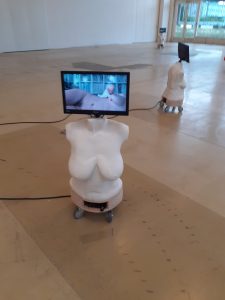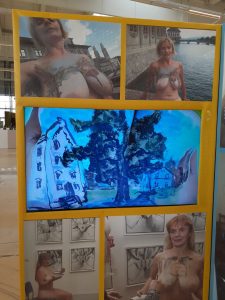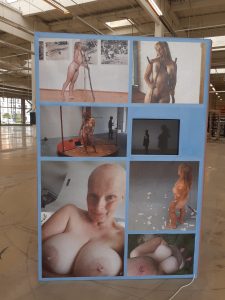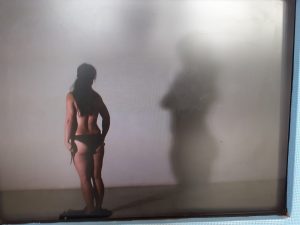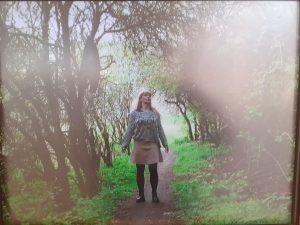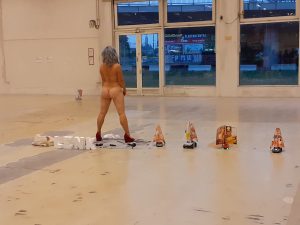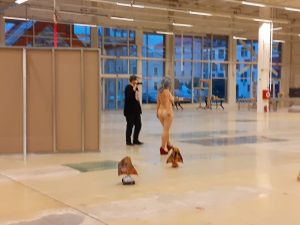Łukasz GUZEK
Body Fiesta or We All Are Animals. Lenka Klodová at Plato Gallery, Ostrava
Body Fiesta – this Spanish-originated word is used here as a reference point to the cultural model of the Baroque epoch that restlessly tried to inscribe death into our lives and thus put life and death next to each other, blurring them in our mind. The Baroque imaginary pictured the mixture of life and death as a lust of the same uncanny origin, and thus built up an inner sensory-driven relation to the surrounding world. Its late sublimation was the explicit eroticism of Rococo art. Then only later did Sigmund Freud give it the name of psychology and turn it into a field of scholarship, and subsequently it was turned into an avant-garde art by surrealism. In the art of the High Baroque, the complex of life and death was presented wrapped up in a rich ornamental decor. Like a fiesta, the realm of art creates a peculiar time-dialectics where real time and fiesta time merge and deprive reality of its gravity in favour of sensuality.
Lenka Klodová uses her own sensuality in the performances that we can see documented in the exhibition titled Lenka Klodová: Leatherette and Other Imitations / Koženka a jiné imitace at the Plato Ostrava City Gallery. She works with a body and with a self-consciousness of a body, her own body. Thus, phenomenologically (after Maurice Merleau-Ponty), she acquires a world-knowledge through her own body. It is her way to get to know and make meaning in her art. This is her highly sensual way to approach reality, to discuss contemporary world-issues in a way where the social and the personal are blurred. She added to the above-mentioned a form of modern feminism and posthumanism (after Rosi Braidotti) where the latter contributes to our animal inner part and interspecies relations based on principles of equality and inclusiveness.
In the curator’s statement, Edith Jeřábková writes about the meaning of the exhibition’s title:
“Leather, skin, leatherette (in Czech koženka), Boženka (Czech female name), the wild girl (in Czech divoženka).” And further: “[Boženka] This diminutive of a Czech women’s name brings to mind Klodová’s work O Boženě (About Božena, 1997), a light inscription BOŽENA shining alternately as BOŽE (My God) and ŽENA (Woman).” That was Klodová’s diploma work at the Vysoká škola umělecko průmyslová (VŠUP) in Prague (1997). The artist herself claims that the title refers to Božena Němcová, a nineteenth century Czech writer, and a pioneer of feminism in literature (see: Lenka Kukurová, “Lenka Klodová,” [an interview], Flash Art no. 50 (2019): 24-28). Božena is also the first name of Klodová’s daughter and this contributes to the joint interpretations of her bodyart works and family subject matter. Which is only proof that the title is multilayer and thus it encourages interpretation. Such a pun, a play on words is not only a literary game, it is a search for meaning. A philosophical way of reasoning that hints that to gain the understanding of a given thing, one should begin from the word. Following this method (and the curator’s suggestions), I will continue this wordplay.
Leatherette – imitation leather – is strongly associated with the body. And it is the body that is a major subject matter of Klodová’s professional interests. Both as an artist and as an academic teacher who runs the Body Design Studio at the Brno University of Technology. Amongst many meanings that the body issue could spark is the body as a means of communication through the senses as a common ground for both sides of this process – the artist and the recipient. Klodová never flirts in art. Her seductiveness is immanent, not a constructed one, and as natural as the beauty of her body. But the body here should be taken rather as a skin, a surface, the visual attraction of which engages the viewer, and thus enables him with the help of its own sensuality to enter into creative dialogue concerning various issues of the contemporary world. So the body opens the mind and as an art means it is ground-breaking in the sense that it is challenging for socio-cultural superstitions and prejudices as well as those concerning the forms and definition of art. The body is always liminal and thus it tests the limits of a beholder’s viewpoints. And, because in the process of reception we perceive the body through identification with our own, each bodily action that one is looking at is felt as close and direct as one’s own experience. In this exhibition, the body is presented in its sensuality and it is this sensuality that appeals to the viewer’s own sensuality, his/her animal part hidden underneath the dominant culture rules. Klodová’s artworks deal with eroticism as it is presented in pop culture, but at the same time she is pointing to the body as vanitas. And both of these attitudes remain tied up in a dialectic knot as a course of life or a nature of our being in the world. This requires from the viewer to reach beyond his/her own limits, and that is the difficult task that she sets in her art.
The exhibition was composed of two complementary parts: The Torsos – comprising five plaster casts of life-size torsos (her own and female members of her family, as the curator claims), with a TV display mounted in the place of their heads on which the artist’s video-performances are presented. The torso-objects have small wheels added to their bases, which is a clever solution that enable flexibility in arranging the installation in the gallery space. The second component is comprised by The Magazines– these are three objects, two standing, of the same height as a human, and one of the same dimensions lying on the floor. They have TV displays mounted in them for showing video-performances or video documentation screenings (at least nine video materials are presented). TheTorsos and The Magazines are performative objects, designed to conform to the life art presented on them. In her artistic career, Klodová has made several objects of this kind (my favourite is a portable plein-air toilet for ladies, a truncated-cone construction made of wooden slats, half open on one side, 80 x 80 x 70 cm, for installing, for example in a park; see photo in: Lenka Kukurová, “Lenka Klodová,” [an interview], Flash Art no. 50 (2019): 26).
The surfaces of the panels of The Magazines were designed to resemble the pages of a paper publication, set as it were as oversized open pages simply standing on the floor. The form of the design of the pages is composed as an arrangement of photo-documentary images of performances where some of them are projections on TV displays. Each page was composed differently, with at least one video screen included. Thus the pages’ composition reflected the dynamic nature of the performance art presented. Additionally, the still images are manipulated in such a way that the figure of the artist is repetitively multiplied on single photos in a collage style which highlights the performative character of this form of art. A mixture of still and moving images corresponds well with the artists attitude to the body as a personal, handy tool and a primary material always accessible at every stage of her performance artist career (the eldest performance art works in this presentation were as old as ten years, but most of the material comes from the last six to five years ending with the works of 2020,which corresponds with the artist’s most busy period,the FNAF festival curatorship included).
All the exhibits – The Torsos and The Magazines’ pages – were arranged in the gallery room rather loosely, this enables the viewer to move freely within the installation, choosing to look at different materials randomly. This aspect contributes to presenting Klodová’s works as one, unified oeuvre with the body as the predominant subject matter. The documentary film and photomaterials are structured only basically, without a clear explanation of their chronology or topics – we are looking at the magazine-panels as someone who is flipping the pages of a magazine looking through its content. Its layout resembles the visual design of a low profile erotic publication, where thick lines in bright colours border the images to single them out and attract the onlooker’s gaze. These characteristics of the soft porn press are used here to build a critical narrative of these documentary images of the artist’s performances. The exhibition is designed for a particular way of reception as it would be in a paper publication that we may read back and forth. The history that is told here has no end nor beginning set in a specific time flow. And as the beginning and the end are not set and are exchangeable, the way to read the exhibits depends only on the reader/viewer’s preference. The artist’s life is a story to tell.
Nevertheless even though the documentary exhibition is arranged as a magazine that can be randomly flicked through, it at least has a first and last cover. The title on the first page reads PředLenka – which could be roughly translated as Before-Lenka (or early Lenka), while the back cover reads PoLenka – After-Lenka (or post-Lenka). The first one is an image of the artist with a weird face-mask, which takes the form of a symbol of today’s pandemic reality. Although it is correctly worn, its central part has been cut out so it is reduced to a golden rhomboid rim left around her mouth showing off the bare lips. As the title informs us, it is called a Vaginal Veil. Together, the horizontal line of her lips and the rhomboid outline, form a rhomboid with a diagonal section. This figure of a rhomboid divided in two with a line appears in Klodová’s art more often as an icon symbolising a vulva, which is here a manifestation of her dedication to feminism as a political power. A veil-mask unveiling the mouth could be read here as a sense and an ability to speak up through sexuality in favour of woman’s rights as human rights. A vertical rhomboid is seen on one of the photos as a situation created within an installation constructed of a rhomboid shaped tunnel with the artist visible posing at the end of it, standing naked with joined hands stretch upward vertically. Together, when looked from a certain perspective, they form for the viewer a complete image that suggests the vulva symbol. The title No entry sounds like declaration against violence against women in line with the ‘Me too’ movement. On the same page-panel is presented a video documentary of a performance based on throwing clothes out through a window when the public was looking at this action from the street. The action took place in the evening, and in the darkness, the window of the brightly-lit room looked like the frame of a canvas. The title, Defenestration, could be read as a credo-statement of the artist and teacher of naked forms and body design, which at the same time is a political gesture (the “Defenestration” was a historical event from the Czech history of the struggle for independence). At the end of this performance in the window, the vulva symbol was presented and thrown out to the street as its last stage.
The body and clothing are both contradicting and supplementing each other at the same time, put on and taken off, presenting and representing, asking a dialectic question about what is the primary: nature or culture, which is a recurrent subject of her performances, appearing here on many photos documenting her games with clothes. A version of this naked/clothed game was to paint a bare body in a way that it seems to be clothed or to be an abstract painterly form painted on the body. In this way, the paint is worn directly as a coloured skin which is a cover or an ultimate clothing. This directs our interpretation to the discussion on making our world a more inclusive one and free from racism, or to another subject – criticism of fashion as a critique of representation of a not-natural picture of the self that we are creating, prompted by mass fashion makers of a usually unfair reputation as an exploitation-based trade. Both the first and the later are a contemporary deep political thinking subject of a human-responsible art. A manifestation of the naked/clothed body dialectic was an animated video (In the bushes) in which on a mysterious forest path, a miracle happened when by a secret power the clothes were taken off and put back on a passing girl (the artist), a magnetism of nature that calls us to unveil the naked truth even for a short moment which is a moment of liberation and thus a change of the individual and social self. This body and clothing game was (re)presented as well by the performance documented on a film displayed on screens mounted on the one of The Torsos series objects. In this film, the artist took female panties out of her mouth one by one. Her ‘speech,’ replacing oral expression with visual images, voicing critically a common pop porn imaginary (Oral Striptease).
Using one’s own body as a political stance was expressed in the performance in which she wrote on her body the names of various ministries that usually compose any government (New Government). This could be read in the light of Foucault’s description of disciplinary power, any power that always aims to gain control over citizens through subjecting their bodies and sexuality to control. The naked body was in western art iconography both a feature of heroes and of gods, or a feature of humble status or deprivation. So any nudity is political in itself. Even as pornography it is located outside society, on the verge of the system. The body when it appeared in culture as a subject matter always produces an effect of detournement, in the terms of Guy Debord, in a course to subvert the established values.
In Klodová’s body art works, painting, an old art discipline, is combined with performance art, a new one. In multiple performances, she used her own body as a support, like in the above-mentioned painting-clothing series of works. Thus old and new media compete on her body. Structuralism in painting meant to focus on the texture of the picture plane made of paint or other materials bearing pictorial qualities that due to them were used in painting. It could even be a bare canvas. Here it is a bare body that provides a structural matter of the painting.
Structuralist painting was an abstract artform, due to its avoiding representation. Here direct inclusion of the body into the painting makes the issue of representation irrelevant as there is no division into the represented and the representing. And the identity is achieved through the involvementof her own body.The motif could be any:figurative or abstract, it could be a landscape or a portrait. In the painting performance, she painted directly on her body using her breast and the upper part of the body as a support. For example, the Zurich performance (Look, view of Zurich) was also a public appearance that could be read as a mimicking a street view maker (vedutista) or portrait maker (Hommage). A documentary film from her bodypainting performance presents in a close up as abstract features, the skin texture included in the painting structure (Klenová of my body). Thus the physicality of the artist’s body linked old and new art categories in a new one, a performative one.
The body painting method has been used by Klodová to elaborate another leading topic of her art – the family.The family here is taken as an open structure which is already subversive enough because families are always self-contained. It is represented by The Torsos placed standing in a gallery room, and also by the numerous performances in which she painted the heads of children on her breasts, carried and cradled them as if they were small babies in their mother’s arms (photos and video performance Family at the Table). Giving birth is a body feature as natural as eroticism. In pop culture’s visual and literary production, however, these two functions are not taken up jointly but are usually discussed as separate culture role models. This is an artificial construction of cultural discourses that is contrasting with common sense, which Klodová seems to overcome in her art. Another of her videos that deals with family issues is a sketchbook or a Diary presented placed between her legs, spreading when she was opening subsequent pages and explaining its content concerning the love affairs and childbirth as a natural combination. Interestingly, her body Painted Family pictures are presented on the panel-page together with the video performance titled Kitchen Circus – Trick with Knives where the artist, filmed in the kitchen, plays a trick with knives put in between her breasts and buttocks and pulled out with no harm, thus commented on a traditional woman’s household role.
The holistic, pan-natural philosophical approach towards the body is able to reconnect the culture-rooted juxtapositions imposed on the woman’s body, in a way that here, in light of Klodová’s art, seems a more effective solution than social activism. Even though the latter goes in the same direction, it is art that moves imagination more directly. The same approach unites the body with the other species, our close others. The artist explores this unity visually by letting the hair on her legs grow (My stockings). Klodová thus enters the critical discourse on the ideal beauty imposed by pop culture. And at the same time she animalized her body. As an animal hairdresser in her own beauty parlour, she braids her legs’ hair and made it look like she wore chequered stockings.In her other like-animal video performances she plays walking like an animal (Walking, breathing, undressing) or pretending to be a ‘crawling’ snake (My grass snake).
In the video performance Seduction of dogs and seduction of cats, she let her pets eat directly from her body food placed on her sensual parts, like breasts and pubic area,which is proof of the same unity (however, each of these animals is doing this in its own, very different way). This image refers to the erotic by association with a sophisticated feast when the eating directly from naked female body is performed, a pattern or icon of imaginary found in literature (for example Bohumil Hrabal, I Served the King of England) or art (Fluxus, for example, Brian Patterson’s Piano piece) and the pop porn, of course. The body showcased on a table as an object for public scrutiny was presented in another performance art documentary piece where she encouraged members of the public to saw off this tables’ legs, which happened successfully, however it cost some efforts to fight to put the table down. The image of the body on the table turns into a vast metaphor when we read the title: Trip your feet with art. To trust the patterns of imagination could cheat us, and it is easy to stumble on art being an inexperienced or inattentive onlooker.Klodová often uses our clichés of imagination, thus deconstructing persistent beliefs about the social role of a woman, when she plays with an images taken from colour magazines or another pattern-image – a naked girl next to a car expressing lust for a machine which was commented by a performance in the public space where she first painted with a red lipstick a cars’ brand signs on the street and then imprinted them on her bare body (Labelling).
Gaze – this is the subject matter of the meta-visual level of (any) art and is particularly vital for the life art. It was taken up in Klodová’s performance titled Red weeds.This is a performance piece for the camera, but its form is untypical for this type of art. And this is a unique form that makes it worth particular consideration. It is a performance of the type when the artist is continuing an action as long as a given particular condition could be stood. A camera is filming two wild poppy flowers, set for the camera as if replacing the eyes of the performer situated right behind them. The flowers were wilting away in the heat of the bright sun. The artist was suffering equally and in parallel, sweating in the burning sun. The action ends when the flowers died. This is the partnership with nature depicting in many ways in Klodová’s art. However here the subject matter is the gaze taken up as a crucial psychological issue for the art, a body art in particular, and for its social relations. The broader interpretation could be developed with Jacques Lacan and his considerations on gaze based on the picture by Gustave Courbet, Origin du Monde that Lacan owned and we may rightly speculate that it inspired him as a lust of gaze of the same kind that forced someone to originally commission it a long time ago. The same painting can be read as a core example for the issue of art and porn. Klodová explores the subject matter of the gaze as a performance artist and body researcher dealing with its multilayer nature, that contradicts the individual and the social.
The social feminist issue is addressed in a video (My doctors) depicting her laying naked and playing with two hand puppets of men (set on her hands) who, dressed in medical doctors’ outfits, examine and caress her body. This puppet theatre on her body is a mockery. The artist is mocking men – and on a broader plan a social subject/object relations coded deeply in the patriarchal culture. A substantial dose of humour makes the criticism even sharper and the more acute. However this video contributes to her manifestations on this topic.
The PoLenka part showcased on the magazine-like panel-page a constellation of pictures from the last period when the artist worked with the body under pressure, which means in the status of illness in a medical sense. The changes of the body, a natural process anyway, is visualised here by her bald head which in the picture was transformed by painting, with a third nipple added on the top of her head, which represents a subject of constant thinking with no escape from it. In this section is presented photo-documentation of the performances when the artist is walking supporting her breasts with some kind of stilts or a traveller’s cane (e.g., like Moses or St. Christopher). This type of body support can be found in Salvador Dali’s paintings showing a traumatized body (Female pilgrim). On the same panel, a video documentary of performance Dressed and naked shadow is presenting where the artist re-enacting the Cut piece by Yoko Ono in a way that her shadow on the wall is juxtaposed and completed by the life action of the artist cutting off piece by piece her clothes with tailor’s scissors held in both hands (she is controlling the action looking at the shadow-image). Thus she stripped herself but at the end only the blurred shadow mysteriously (intriguingly) remained on the wall, naked. PoLenka is the last page but not least. The body still served the game with life art and the meanings it produces. From the first to the last cover, the documentary images symbolically picture lust engulfing the life as art. Baroque-like sensuality frees art from the mundane while at the same time, the social and political involvement make it interfere with the real life.The artist balances the high-flying imagination at large and the contextual, and it is the body that makes it surreal and grounding it at the same time. All with a big portion of a sense of humour.
Appendix
The summary, but also a supplement to the presentation of the documentation at the exhibition, was a live performance by Klodová. In this piece, the artist referred to her interest in nudity in visual culture, namely the images in colourful erotic magazines. Her case study was Leo magazine, which has been published in Czechia since the nineties of the last century. Before the performance, the artist conducted research examining the changes that had taken place in the way that the eroticism was depicted on the photos published in it, in other words, changes in the style of illustrating the male erotic imagination. At the beginning of her performance, the artist proposed to the audience to make ‘face-masks’ using strips of pages cut out from the magazines, which is a reference to the time of the COVID-19 pandemic. During this part of the action she was dressed. Then the viewers went to the space of her exhibition installation where the artist lay down on a mat on the floor. Using remote control devices, she caused a few toy bumper cars to come driving to the performance venue from behind one of The Magazines objects.Then the open pages of the Leo magazines, selected from different periods of this publication, older and newer, were mounted on the cars. The cars moved in different directions, back and forth, so the pages functioned as ‘sails’, looking as if they were being nervously looked through by some phantom viewer. At a certain stage of the action, a ‘herd’ of cars with erotic pages were‘parked’ around the artist lying in a relaxed pose. The artist, then undressed, still lying naked surrounded by car-pages, began to assume poses that resembled the illustrations from the Leo magazine. However, as it turned out, their meaning here was different. The poses were to performing the letters of the alphabet, that finally formed the word LENKA, a kind of signature of the exhibition installation of her one woman show. Then the artist handed over the remote control devices to the members of the audience. The last scene was when naked, in high heels and a colorful wig, again performing as images from the Leo magazine, she strolled through the vast space of the Plato gallery, while a ‘herd’ of cars followed her, waving their pages, until at the end they passed behind a curtain.
published 2022
made possible by NAWA
Lenka Klodová: Leatherette and Other Imitations/ Koženka a jiné imitace
Curator:
Edith Jeřábková
July 14–October 3, 2021
Vernissage: July 14, 2021
Performance by Lenka Klodová (live): September 29, 2021, at 6 pm







